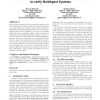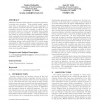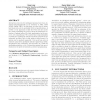ATAL
2009
Springer
15 years 5 months ago
2009
Springer
The Goal Decomposition Tree model has been introduced in 2005 by Mermet et al. [9] to specify and verify the behaviour of an agent evolving in a dynamic environment. This model pr...
103
Voted
HOLOMAS
2003
Springer
15 years 5 months ago
2003
Springer
With the growing usage of the world-wide ICT networks, agent technologies and multiagent systems are attracting more and more attention, as they perform well in environments that a...
ATAL
2003
Springer
15 years 5 months ago
2003
Springer
Abstract. Starting from a general definition of how to model the organisation of multiagent systems with the aid of holonic structures, we discuss design parameters for such struc...
ATAL
2003
Springer
15 years 5 months ago
2003
Springer
Distributed Internet-based attacks on computer systems are becoming more prevalent. These attacks usually employ some form of automation and involve the compromise of many systems...
132
click to vote
ATAL
2003
Springer
15 years 5 months ago
2003
Springer
Security plays an important role in the development of multiagent systems. However, a careful analysis of software development processes shows that the definition of security requ...
82
Voted
ATAL
2003
Springer
15 years 5 months ago
2003
Springer
Interaction protocols for multiagent systems have been described diagrammatically in an extension of UML called AUML (Agent UML). In this paper, we show how to translate these pro...
ATAL
2003
Springer
15 years 5 months ago
2003
Springer
This paper describes how multiagent systems can be used to achieve robust software, one of the major goals of software engineering. The paper first positions itself within the sof...
104
Voted
ATAL
2003
Springer
15 years 5 months ago
2003
Springer
The problem investigated in this paper is the distribution of goals addressed to a group of rational agents. Those agents are characterized by their ability (i.e. what they can do...
137
click to vote
CSFW
2003
IEEE
15 years 5 months ago
2003
IEEE
We provide a framework for reasoning about information-hiding requirements in multiagent systems and for reasoning about anonymity in particular. Our framework employs the modal l...
SOFSEM
2004
Springer
15 years 5 months ago
2004
Springer
Multiagent software systems are known to exhibit a system-level behavior that rarely can be predicted from the description of individual agents but must be observed in simulation o...



